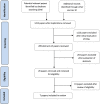Interventions for women who have a caesarean birth to increase uptake and duration of breastfeeding: A systematic review
- PMID: 27882659
- PMCID: PMC6866035
- DOI: 10.1111/mcn.12390
Interventions for women who have a caesarean birth to increase uptake and duration of breastfeeding: A systematic review
Abstract
Rates of breastfeeding uptake are lower after a caesarean birth than vaginal birth, despite caesarean rates increasing globally over the past 30 years, and many high-income countries reporting overall caesarean rates of above 25%. A number of factors are likely to be associated with women's infant feeding decisions following a caesarean birth such as limited postoperative mobility, postoperative pain, and ongoing management of medical complications that may have triggered the need for a caesarean birth. The aim of this systematic review was to evaluate evidence of interventions on the initiation and duration of any and exclusive breastfeeding among women who had a planned or unplanned caesarean birth. Seven studies, presenting quantitative and qualitative evidence, published in the English language from January 1994 to February 2016 were included. A limited number of interventions were identified relevant to women who had had a caesarean birth. These included immediate or early skin-to-skin contact, parent education, the provision of sidecar bassinets when rooming-in, and use of breast pumps. Only one study, an intervention that included parent education and targeted breastfeeding support, increased initiation and continuation of breastfeeding, but due to methodological limitations, findings should be considered with caution. There is a need to better understand the impact of caesarean birth on maternal physiological, psychological, and physical recovery, the physiology of lactation and breastfeeding and infant feeding behaviors if effective interventions are to be implemented.
Keywords: breast pumps; breastfeeding duration; breastfeeding support; caesarean section; rooming-in; skin-to-skin.
© 2016 John Wiley & Sons Ltd.
Conflict of interest statement
The authors declare that they have no conflicts of interest.
Figures
References
-
- Aune, D. , Norat, T. , Romundstad, P. , & Vatten, L. J. (2014). Breastfeeding and the maternal risk of type 2 diabetes: A systematic review and dose‐response meta‐analysis of cohort studies. Nutrition, Metabolism, and Cardiovascular Diseases, 24, 107–115. - PubMed
-
- Bai, D. L. , Wu, K. M. , & Tarrant, M. (2013). Association between intrapartum interventions and breastfeeding duration. Journal of Midwifery & Women's Health, 58(1), 25–32. - PubMed
-
- Bowatte, G. , Tham, R. , Allen, K. J. , et al. (2015). Breastfeeding and childhood acute otitis media: A systematic review and meta‐analysis. Acta Paediatrica. Supplement, 104, 85–95. - PubMed
Publication types
MeSH terms
LinkOut - more resources
Full Text Sources
Other Literature Sources
Medical
Miscellaneous



